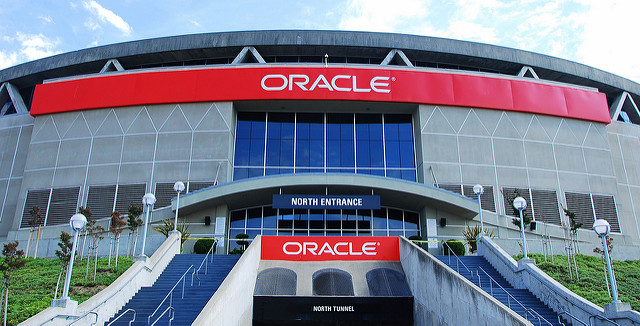Oracle Takes On AWS Next
Nearly three years ago, tech giant, Oracle (NYSE: ORCL) began its transition toward the cloud. Since the change in gear, Oracle has seen both revenues and profits fall. Finally, it now appears that the worst is over. As Jefferies & Co. analyst John DiFucci puts it, the “clouds are clearing”.

Photo Credit: May Wong/Flickr.com
Oracle’s Financials
After four successive quarters of decline, Oracle’s third quarter revenues finally grew 3% over the year to $9.3 billion. The analysts were estimating revenues of $9.256 billion. EPS of $0.69 for the quarter, was also ahead of the Street’s forecast of $0.62.
By segment, Cloud Software as a Service (SaaS) and Platform as a Service (PaaS) revenues grew 73% to $1 billion. Total Cloud Revenues, including Infrastructure as a Service (IaaS), grew 62% to $1.2 billion. Total On-Premise Software Revenues fell 3% to $6.2 billion. Hardware revenues continued to decline and fell 9% to $1.03 billion.
It announced a quarterly dividend of $0.19 which was 27% higher than last quarter’s payout.
For the current quarter, management forecast revenues to be in a range of 1% decline to 2% increase, translating to a mid-point of $10.68 billion. Oracle forecast an EPS of $0.78-$0.82 for the quarter.
Oracle’s Cloud Growth Continues
Of late, Oracle’s growth has been all about the Cloud. It is convinced that there is more good news to come within Cloud as it shifts gears to take on Amazon. As CEO, Larry Ellison, mentioned on the call,
“SaaS and PaaS are large, rapidly growing businesses for us. Together SaaS and PaaS grew 85% this past quarter. But soon Infrastructure-as-a-Service will be growing even faster and before long Infrastructure-as-a-Service will become Oracle’s largest cloud business”.
Its earlier acquisition of NetSuite is also helping achieve this goal. Oracle claims that it is now able to offer to customers a product that has better performance and higher cost efficiency than that available through AWS. The Gen 2 of Oracle IaaS delivers ultra-high database performance and form caller reliability in the cloud. It is able to support Oracle workloads at run times that are as much as ten times faster versus the Amazon cloud. Oracle expects to see some large customer wins in the next few weeks as they negotiate huge Infrastructure-as-a-Service contracts to move all their databases to the Oracle cloud.
Additionally, Oracle is also upping the ante by engaging in a price war to rake in a bigger market share. In February this year, it changed the terms of its licensing policy so that its customers must pay double the cost of running Oracle’s software on Amazon’s cloud environment. The change in policy will make AWS a more expensive option for customers when compared with running the service on Oracle Cloud.
Despite the moves, taking on Amazon is a tough battle. Amazon remains the biggest cloud IaaS player around with 37% market share. Microsoft’s Azure is a distant second with 28% market share followed by Alphabet in the third position with 17% share. AWS revenues came in at $12.2 billion last year, compared with Oracle’s annualized run rate of $4.8 billion based on its third quarter’s results.
But the market is pleased with Oracle’s performance. Its stock is currently trading at $44.52 with a market cap of $183.19 billion. It touched a 52-week high of $46.69 soon after its result announcement. It had fallen to a 52-week low of $37.62 in October last year. The result announcement also saw the stock receive two upgrades from JP Morgan and JMP securities. Other analysts also raised their price targets to as high as $53.
It’s an excruciatingly painful exercise for a licensed software company to move to a subscription pricing model. It creates havoc with revenues. The three years of declining revenues are common for all companies who try to make this shift. However, at this stage of the software industry’s evolution, there is absolutely no choice but to go this route, and Oracle has known that for a while. The move is going well, and analysts recognize that.
As for the next bet of taking on AWS, it will surely be an exciting battle to see unfold.
Sramana Mitra is the founder of One Million by One Million (1M/1M), a global virtual incubator that aims to help one million entrepreneurs ...
more


